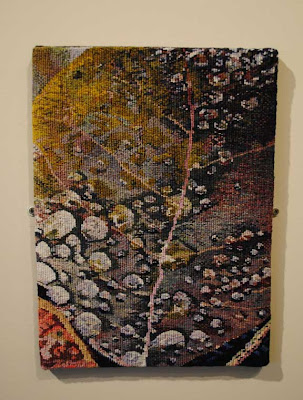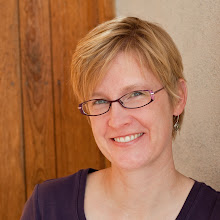 This week I went to Lincoln, Nebraska to see the American Tapestry Alliance's ATB8 show at the Elder Gallery at Nebraska Wesleyan University. I am glad that I went (despite the 1700 mile total drive!). The show was inspiring and I was grateful to have the opportunity to study the tapestries first hand. There were many surprises as the tapestries are quite unlike the reproductions in the catalog. Don't get me wrong, the catalog is lovely, but the photographs don't capture the real feeling of many of the pieces--and how could they? You must experience tapestry in person.
This week I went to Lincoln, Nebraska to see the American Tapestry Alliance's ATB8 show at the Elder Gallery at Nebraska Wesleyan University. I am glad that I went (despite the 1700 mile total drive!). The show was inspiring and I was grateful to have the opportunity to study the tapestries first hand. There were many surprises as the tapestries are quite unlike the reproductions in the catalog. Don't get me wrong, the catalog is lovely, but the photographs don't capture the real feeling of many of the pieces--and how could they? You must experience tapestry in person.The piece that I kept returning to for study was Hallaig by Joan Baxter from Scotland (link to the poem that inspired the piece is here). This piece made amazing use of color which merited close study. I wish I had a few more days to look at this tapestry. After looking at this piece as well as Maximo Laura's Dos Peces Payaso largely with a look to color use, my own piece (Emergence) looked flat to me.

Dos Peces Payaso (Maximo Laura) on left and Hallaig (Joan Baxter) on right.
So I wandered around the gallery some more asking myself which pieces had that flat look and which seemed to draw me in by the use of color. I found that the pieces that had blocks of color and unmixed color bundles did indeed look flatter than the pieces where there were clearly many colors in each bundle of weft. (I think by "flat" I mean that my eye easily interpreted the color in a certain part of the tapestry and moved on looking for more interesting things to look at. While looking at Hallaig and Dos Peces Payaso, that never happened even after several hours of looking.) My piece definitely had color mixing throughout, but the colors mixed were fairly similar in hue and value. But what happens when you throw purple in with brown or green? Magic. I also found myself fascinated with Sarah Swett's Pizzicato and Jane Freear-Wyld's Raindrops and their use of color.

Hallaig detail

Dos Peces Payaso detail

Pizzicato detail

Raindrops
I had other favorite tapestries for other reasons than color use. I enjoyed Sarah Swett's Hang Up and Draw I think for her use of gesture. I was looking forward to seeing this piece in person as I couldn't figure out how she created such smooth beautiful lines with tapestry from the photo. I was surprised to see that many sections of the weaving that I had interpreted as being actual lines of color in the photograph were just slits that were not sewn. The gestural nature of this piece fascinated me, as did the questions it was asking. Nesting #1 and #2 by Inge Norgaard were also pieces that seemed largely gestural and lived large in my imagination. I loved the movement in these two pieces.

Hang Up and Draw detail

Nesting #1 and Nesting #2
Another question I had before seeing the show was about sett. What warp sett do other tapestry weavers use? I always assumed that Sarah Swett, for example, used a sett that was much closer than mine to get the fantastic detail in her tapestries. I was surprised to see that most of the setts in this show were between 4 and 8 e.p.i. with many being around 6. I have been fascinated for years with how the brain interprets what the eyes see and I think this is what is happening in this case. Apparently weaving at very fine setts is not necessary if you look to color use... and also use the brain's tendency to fill in "missing" information. I currently weave at 10 e.p.i., but after seeing this show will consider other setts depending on what I want to communicate.
There were a few pieces with a fantastic sense of humor, and as I believe we need more humor as humans in most areas of life, these were favorites also... Lany Eila's Any Time Now: One Family's Soft-book Primer of Anticipated Catastrophes and of course, Peggy by Joanne Sanburg. Peggy's face graced one of the announcement postcards for this show.

Any Time Now: One Family's Soft-book Primer of Anticipated Catastrophes

Peggy
Seeing this show was a fantastic learning experience for me. I suddenly felt like there was so much exploration to be done--tapestry worlds opening up right at my feet. I couldn't wait to get home to the loom to play with my own use of color and see what jumped out at me.
Here are some shots of the gallery:





The show at the Elder Gallery closes tomorrow. It will open again January 20th at American Textile History Museum in Lowell, MA. The opening is January 20th from 5:30-7:30. The show runs through May 1, 2011.





Thanks for the tour and the musings, many of the things I wonder about myself. I've always admired Sarah Swett's work and would love to see it in person, along with Laura's and others. And, of course, the final picture was excellent!
ReplyDelete